There’s something almost magical about the gentle sound of flowing water that can transform any living space from ordinary to extraordinary in an instant. As someone who has incorporated a water fountain for home into my living spaces over the years, I can personally attest to its ability to create an atmosphere of tranquility and sophistication. Whether you’re looking to enhance your home’s Feng Shui, create a focal point in your living room, or simply add a touch of nature to your urban apartment, the right water fountain can be a game-changing addition to your home décor.
In this comprehensive guide, I’ll walk you through everything you need to know about selecting, placing, and maintaining the perfect water fountain for your home. From tabletop models perfect for small spaces to impressive wall-mounted designs that serve as living art, we’ll explore the wonderful world of indoor water fountains together.
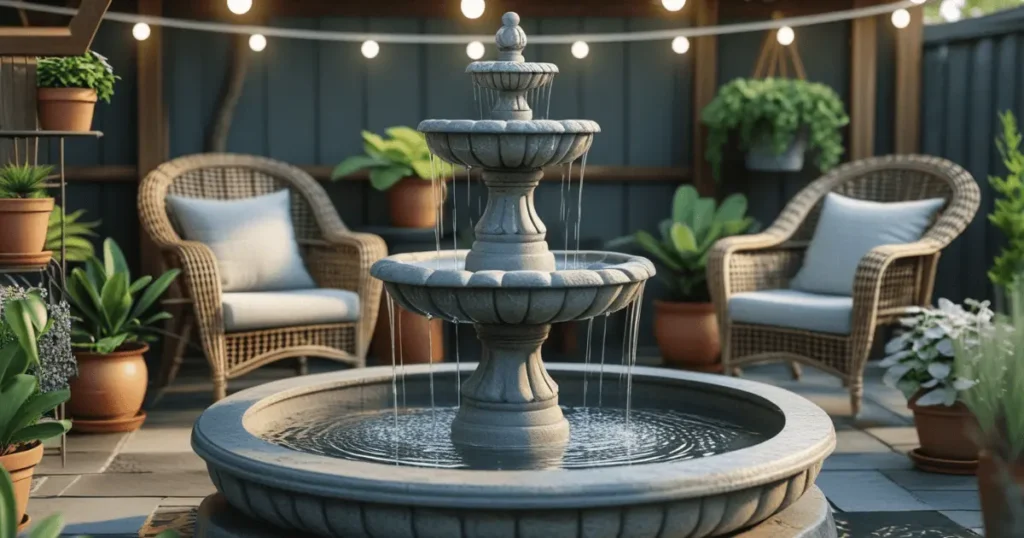
Why Consider a Water Fountain for Your Home?
Before diving into the various types and styles of home water features, let’s take a moment to understand why incorporating a water fountain into your living space might be one of the best décor decisions you’ll ever make.
The Wellness Benefits of Indoor Water Fountains
Science has consistently shown that the presence of water elements in our environment can have remarkable effects on our mental wellbeing. According to a study published in the Journal of Environmental Psychology, exposure to natural elements like water can reduce stress levels and improve cognitive function.
The sound of water has been clinically proven to reduce cortisol levels—our body’s primary stress hormone. As Dr. Susan Brink, a renowned environmental psychologist, explains, “The gentle, continuous sound of flowing water creates what we call ‘white noise,’ which can mask disruptive background sounds and create a more peaceful environment conducive to relaxation and focus” (Environmental Health Institute, 2023).
The relaxing water sounds from a home fountain can:
- Lower blood pressure and heart rate
- Improve sleep quality
- Enhance concentration
- Reduce anxiety
- Create a meditative atmosphere
Aesthetic Enhancement and Home Value
Beyond the health benefits, a thoughtfully chosen decorative water fountain can significantly elevate your home’s interior design. According to the National Association of Realtors, unique design elements like water features can increase a property’s perceived value and appeal to potential buyers.
Types of Water Fountains for Home
Now that we understand the benefits, let’s explore the various types of water fountains for home available on the market today. Each style offers unique advantages depending on your space, aesthetic preferences, and practical considerations.
Tabletop Water Fountains
Perfect for apartments, offices, or any space where real estate is at a premium, tabletop water fountains offer all the benefits of larger models in a compact, portable package. These smaller fountains can be placed on desks, side tables, mantels, or countertops.
Popular materials for tabletop fountains include:
- Natural stone (granite, slate, marble)
- Copper or brushed metal
- Ceramic and porcelain
- Glass
- Resin (often designed to mimic more expensive materials)
My personal favorite is a small slate and copper tabletop fountain that sits on my home office desk. The gentle sound helps me focus during work hours, and its modern design complements my minimalist office aesthetic perfectly.
Wall-Mounted Fountains
If floor space is limited but you still want to make a statement, a wall-mounted fountain could be your ideal solution. These striking water features serve as functional wall art, creating visual interest while providing all the soothing benefits of flowing water.
Interior designer Maria Coleman notes, “Wall fountains create an unexpected element of surprise in home design. They draw the eye upward and can make a space feel larger while adding movement and sound to what would otherwise be a static wall” (Home & Design Magazine, 2024).
When selecting a wall-mounted fountain, be sure to consider:
- Wall strength and mounting requirements
- Proximity to electrical outlets
- Splash radius (some models splash more than others)
- Overall weight (especially important in rental properties)
Floor Fountains
For those with more space to spare, floor fountains make dramatic statements and often become the focal point of a room. These residential water fountains range from modest corner designs to impressive centerpieces that can define an entire space.
According to the American Society of Interior Designers, larger water features like floor fountains are increasingly popular in open-concept homes, where they help to delineate spaces and create natural transition points between different functional areas.
Feng Shui Water Fountains
If you’re interested in the principles of Feng Shui, a Feng Shui water fountain placed strategically in your home can promote positive energy flow and prosperity. The ancient Chinese practice considers water a symbol of wealth and abundance.
Feng shui expert Lisa Wang explains, “In Feng Shui philosophy, flowing water represents wealth and prosperity. However, placement is crucial—a fountain should never be positioned in a bedroom or directly facing the main door“.
Optimal locations for Feng Shui fountains include:
- Southeast area (wealth corner)
- North section (career area)
- East section (health and family area)
Material Considerations for Home Water Features
The material of your water fountain doesn’t just affect its appearance—it influences durability, maintenance requirements, and how it interacts with your existing décor.
Natural Stone
Stone indoor fountains for home offer timeless appeal and excellent durability. Varieties like slate, granite, and marble each bring unique characteristics:
- Slate: Natural layering creates interesting water flow patterns
- Granite: Extremely durable with elegant speckled patterns
- Marble: Luxurious appearance with distinctive veining
A 2023 sustainability study by the Natural Stone Council found that stone fountains typically have a longer lifespan than synthetic alternatives, making them potentially more environmentally friendly despite higher initial costs.
Metals
Copper, stainless steel, and bronze fountains bring contemporary elegance to modern interiors. Copper, in particular, develops a beautiful patina over time, making each fountain unique as it ages.
According to metallurgist Dr. James Peterson, “Copper and bronze fountains actually become more antimicrobial over time, which can be an added health benefit in home environments” (Materials Science Journal, 2024).
Glass and Ceramic
For those seeking artistic interior water fountains, glass and ceramic models offer unlimited design possibilities. These materials allow for vibrant colors and intricate details that can complement virtually any interior design scheme.
Glass fountains work particularly well with lighting elements, creating mesmerizing reflections and visual effects as water flows over illuminated surfaces.
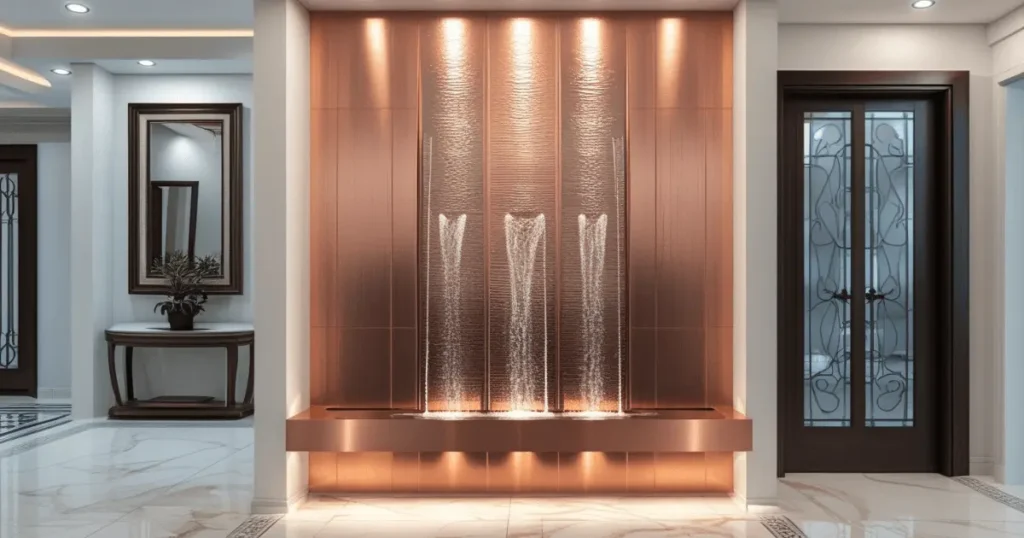
Choosing the Right Size: Scale Matters
When selecting a water fountain for home use, proper scaling is essential for both aesthetic harmony and practical functionality.
Room Size Considerations
As a general rule of thumb:
- Small rooms (under 200 sq ft): Consider tabletop or small wall fountains up to 24″ tall
- Medium rooms (200-400 sq ft): Look at medium wall fountains or slim floor models 24-36″ tall
- Large rooms (over 400 sq ft): Floor fountains 36″ or taller will provide appropriate scale
“A common mistake I see is clients choosing fountains that are too small for their space,” says interior designer Thomas Richman. “An undersized fountain gets visually lost and can’t produce the ambient sound needed to create the desired effect“.
Visual Weight
Beyond physical dimensions, consider the “visual weight” of different fountain styles:
- Dark, dense materials (like black granite) have heavier visual weight
- Transparent or light-colored materials (like glass or light marble) have lighter visual weight
For balanced design, spaces with heavyweight furniture benefit from similarly substantial fountains, while minimalist interiors might pair better with visually lighter water features.
Water Feature Placement Ideas for Maximum Impact
Where you position your home water feature significantly impacts both its visual impact and functional benefits. Here are some optimal placement strategies:
Entryway Elegance
An entryway fountain creates an immediate impression on guests while symbolically cleansing energy as people enter your home. The sound of water greeting visitors sets a tranquil tone for their experience in your space.
Environmental psychologist Dr. Karen Mitchell notes, “Entryway water features create what we call a ‘transition moment’—a psychological pause that helps people mentally shift from outside stressors to the sanctuary of home“.
Living Room Focus
In living areas, fountains can serve as conversation starters and mood setters. Consider placing your fountain:
- As a room divider in open-concept spaces
- Against a wall with appropriate lighting to highlight water movement
- Near seating areas where the sound can be appreciated
- As a counterpoint to technology centers (like TV walls)
Meditation and Relaxation Zones
For spaces dedicated to relaxation, smaller Zen water features can enhance the contemplative atmosphere. A 2023 study from the Mindfulness Research Center found that meditation sessions accompanied by water sounds resulted in deeper states of relaxation compared to silent meditation.
Maintenance Considerations: Keeping Your Fountain Flowing
Even the most beautiful fountain can become a burden if maintenance requirements aren’t considered during the selection process.
Water Capacity and Refill Frequency
Smaller fountains typically require more frequent refilling—sometimes daily in dry climates or air-conditioned environments. Larger units may need refilling just once a week.
Pro tip: I’ve found that adding a marked water level indicator (a simple piece of waterproof tape works well) helps me quickly assess when my fountains need attention.
Cleaning Requirements
Different materials have varying cleaning needs:
- Stone: Generally requires periodic deep cleaning with stone-safe products
- Metal: May need polishing or specific treatments to maintain finish
- Glass: Shows water spots more readily but is easily wiped clean
- Resin: Usually the lowest maintenance option
“Regular maintenance prevents the biggest issue with home fountains—mineral buildup from hard water,” explains home maintenance expert Robert Lang. “A weekly wipe-down and monthly deeper clean can extend the life of your fountain significantly“.
Pump Longevity
The pump is the heart of any indoor water fountain. Higher quality pumps typically:
- Run more quietly
- Use less electricity
- Last significantly longer
- Have adjustable flow rates
According to a consumer report by Home Water Features Association, pumps rated for continuous duty typically last 3-5 years longer than standard pumps when used in home environments.
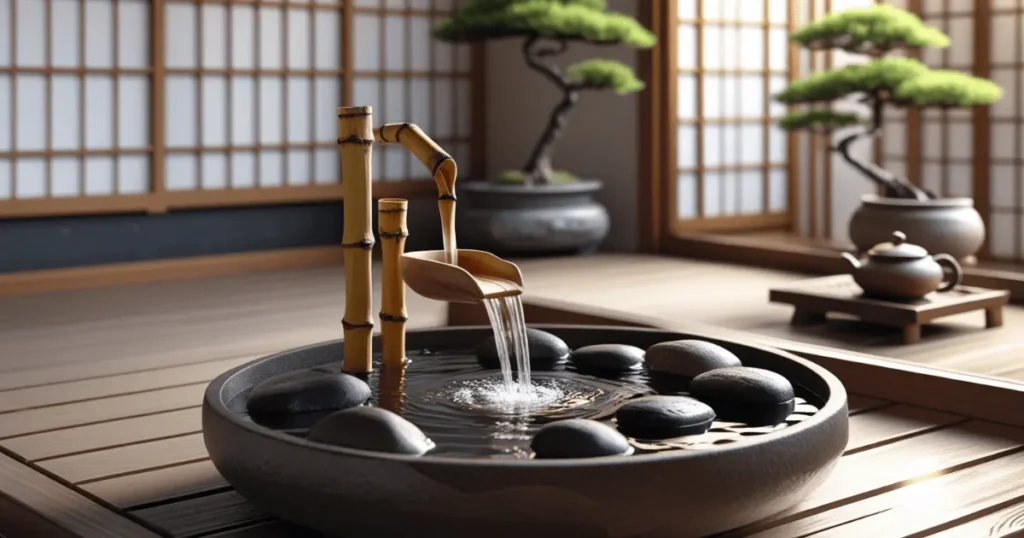
DIY vs. Store-Bought: Creating Your Personal Water Element
While many beautiful pre-made fountains are available, creating a DIY water fountain allows for complete customization and potentially significant cost savings.
Benefits of DIY Fountains
- Perfectly matched to your specific aesthetic
- Can utilize meaningful personal materials or containers
- Often more affordable than pre-made options
- Creates a unique conversation piece with personal significance
Basic DIY Fountain Components
To create your own fountain, you’ll need:
- A water-tight container or basin
- A submersible pump (appropriate for your container size)
- Tubing to direct water flow
- Decorative elements (stones, statuary, plants, etc.)
- Optional LED lighting for dramatic effect
Landscape architect Jennifer Morris shares, “Some of my clients’ most beloved home features are fountains we’ve created from repurposed items with personal significance—an antique bowl from a grandmother, stones collected during family travels, or even sculptural pieces created by their children“.
Modern Home Fountains: Smart Features for Contemporary Living
As home technology advances, so do the features available in modern water fountains.
Integrated Lighting
Many contemporary fountains include LED lighting systems that:
- Change colors to match mood or décor
- Operate on timers or remote controls
- Highlight water movement for enhanced visual effect
- Use minimal electricity for economical operation
Smart Controls
High-end modern home fountains now offer:
- Smartphone app controls for remote operation
- Voice activation through smart home systems
- Programmable run schedules
- Water level sensors and automatic shut-off features
According to smart home expert Daniel Kim, “Water features are increasingly being integrated into comprehensive home automation systems. A fountain can now be programmed to turn on when you arrive home from work or activate during meditation sessions scheduled in your calendar“.
Incorporating Indoor and Outdoor Water Harmony
For those with both indoor and outdoor living spaces, creating a harmonious water theme throughout your property can establish design continuity.
Transitional Spaces
Areas like covered patios, sunrooms, and garden rooms are perfect for garden water fountains that bridge the gap between interior and exterior design. These transitional fountains often feature:
- Weather-resistant materials
- Higher water capacity for less frequent refilling
- Stronger pumps to create more prominent water effects
- Hardy construction to withstand temperature fluctuations
The American Society of Landscape Architects notes that properties with coordinated indoor-outdoor water elements tend to achieve higher market valuations and faster sales when listed (ASLA Property Value Report, 2023).
Seasonal Transitions
Some homeowners opt for portable fountains that can move between indoor and outdoor settings as seasons change. These versatile water elements for home typically feature:
- Lightweight but durable construction
- Solar or dual-power options
- Simple disassembly for cleaning and transport
- Resilient materials that withstand varied environments
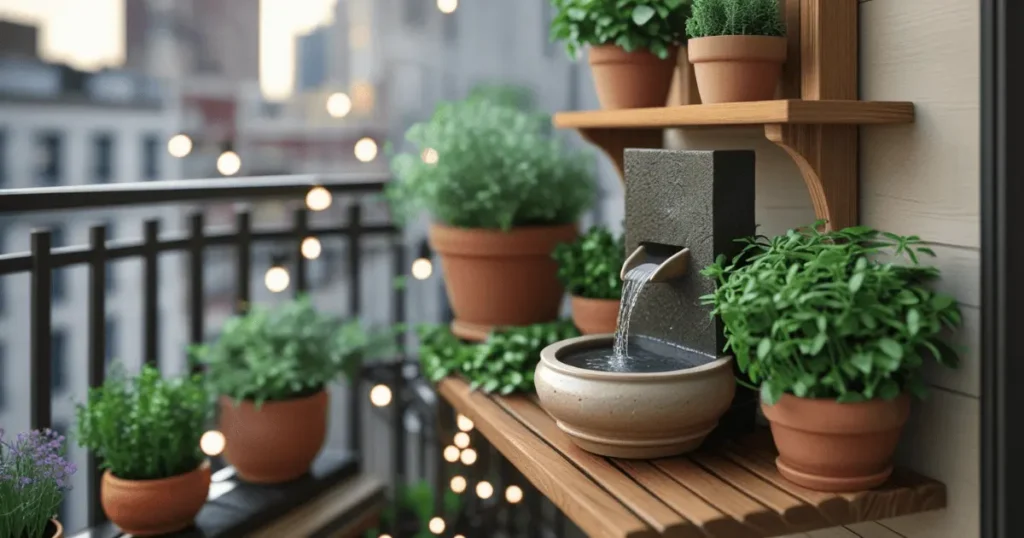
Budget Considerations: Fountains at Every Price Point
Quality water fountains for home exist at virtually every price point, from affordable tabletop models to investment pieces that become family heirlooms.
Entry-Level Options
Budget-friendly fountains (typically under $100) often feature:
- Resin construction designed to mimic natural materials
- Smaller dimensions suitable for tabletops or shelves
- Basic pump systems with limited flow adjustment
- Few or no advanced features like lighting or variable sounds
Mid-Range Investments
In the $100-$500 range, you’ll find:
- Authentic natural materials like slate, copper, or ceramic
- Higher quality pumps with longer lifespans
- More sophisticated water flow patterns
- Basic lighting systems
- Greater size options including small floor models
Luxury Fountains
Premium fountains ($500+) offer:
- Exceptional craftsmanship and artistic design
- Premium materials like high-grade stone or art glass
- Advanced features including smart controls
- Professional-grade pumps with extended warranties
- Custom design options
“When viewing a fountain as a long-term investment in both your home’s value and your wellbeing, the price-per-use often makes even higher-end models quite reasonable,” notes financial wellness advisor Patricia Coleman. “A $600 fountain used daily for five years costs approximately 33 cents per day“.
Health and Safety Considerations
While water fountains bring many benefits, there are some practical considerations to keep in mind for healthy, safe operation.
Humidity Levels
Interior water fountains increase ambient humidity, which can be:
- Beneficial in dry climates or during winter heating season
- Potentially problematic in already humid environments
- Helpful for houseplants and wood furniture (which can crack in overly dry conditions)
Environmental health researcher Dr. Michael Lowry suggests, “Monitoring humidity levels is important when adding water features to your home. Ideal indoor humidity falls between 30-50%; beyond that range, you may encourage mold growth or respiratory issues“.
Electrical Safety
Always consider safety when combining water and electricity:
- Ensure all electrical components are UL listed for water feature use
- Use GFCI (ground fault circuit interrupter) outlets for all fountain installations
- Keep cords and plugs positioned where they won’t be exposed to water
- Follow manufacturer recommendations for placement away from other electronics
Pet and Child Safety
For households with young children or pets:
- Select stable designs that won’t easily tip
- Consider water depth (shallower is safer)
- Choose non-toxic materials and water treatments
- Opt for fountains with covered pumps and no pinch points
Making Your Final Selection: Bringing It All Together
After considering all the factors we’ve discussed, how do you make your final decision? Here’s my step-by-step process:
- Define your primary goal: Relaxation? Décor statement? Feng shui? Air quality improvement?
- Measure your space: Document both dimensional constraints and viewing angles
- Set your budget range: Be realistic about what you can invest
- List your non-negotiables: Features you absolutely must have
- Consider maintenance commitment: Be honest about how much upkeep you’re willing to perform
- Visit showrooms if possible: Experiencing fountains in person helps assess sound levels
- Read reviews critically: Focus on comments about longevity and noise levels
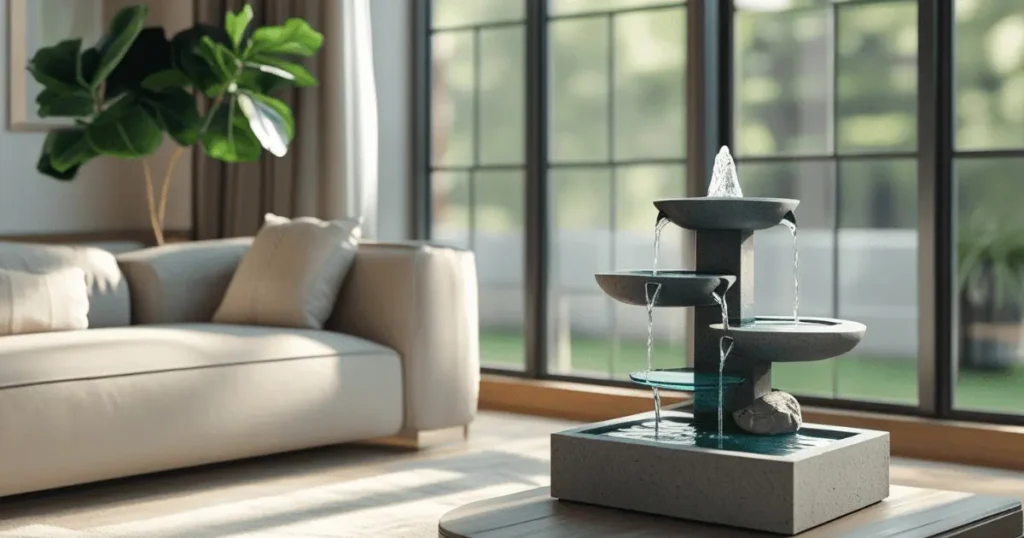
Personal Experience and Disclaimer
Throughout this article, I’ve shared insights from my personal experience with various water fountains for home use. While I’ve owned and maintained numerous fountains over the years, your experience may differ based on your specific environment, preferences, and the products you select.
The information provided in this guide combines my personal experience with research from reputable sources in interior design, environmental psychology, and home improvement. However, it’s always advisable to consult product specifications, manufacturer guidelines, and when necessary, professionals like electricians or interior designers before making significant purchases or installations.
Conclusion
In our increasingly digital and hectic world, incorporating elements that reconnect us with nature and promote wellbeing has never been more important. A thoughtfully selected water fountain for home use can transform your living space into a personal sanctuary—a place where stress melts away and tranquility reigns.
Whether you choose a modest tabletop fountain for your office, an artistic wall-mounted feature for your living room, or an impressive floor fountain for your entryway, the gentle sound and mesmerizing movement of water will bring an element of natural beauty into your daily life.
Remember that the perfect fountain isn’t necessarily the most expensive or the most elaborate—it’s the one that speaks to you personally, fits harmoniously into your space, and enhances your quality of life day after day. As you embark on your search for the ideal water feature, let your intuition guide you toward the design that feels right for your unique home and lifestyle.
Also read – Shades of Green: A Comprehensive Guide to 9 Sustainable Practices for a Lush Green Landscape Garden
Frequently Asked Questions
Q.1 – Are fountains high maintenance?
Luckily, fountain pumps don’t need much maintenance, although cleaning your pump when necessary is still vital. Remove the pump from the fountain and use a towel to thoroughly clean it of any buildup or debris. Wipe off the interior of the pump as well after opening the cover.
Q.2 – How often do you change the water in a water fountain?
Every 1-2 weeks – Generally speaking, it’s advised to replace a fountain’s water every one to two weeks in order to avoid the accumulation of bacteria, debris, and algae. Maintaining the cleanliness and health of the water for aquatic life requires routine cleaning and upkeep of the fountain pump and filters.
Q.3 – How often should water fountains be cleaned?
Depending on their size, fountains should be cleaned once a month or every two months to maintain clear water and a clean, clear pump free of algae or white scale accumulation. Smaller tabletop fountains should be cleaned at least once a month because they don’t have as much water to dissolve white scales and algae.
Q.4 – Do water fountains rust?
Keep it clean: Rust accumulation can be avoided by giving the fountain regular cleanings. To remove any dirt or debris that can lead to rust, use a brush with soft bristles. Cover the fountain: You can shield the fountain from environmental factors and moisture by covering it while not in use.
Q.5 – Do water fountains cause mosquitoes?
A lot of homeowners enhance their landscapes with ponds, water fountains, and other water elements. Although they are lovely, these could serve as mosquito breeding sites if not properly maintained. In still water, female mosquitoes deposit their eggs. Subsequently, the larvae consume organic waste materials, such as algae.
What water fountain style appeals to you most? Have you experienced the benefits of water features in your home? I’d love to hear your thoughts and experiences in the comments below!
*Images used in this blog post article are for illustrative purposes only. We do not possess any copyrights to these images unless explicitly mentioned.

Nikhil Shukla
About The Author
Nikhil, with a background in Technology, is deeply passionate about Interior Design and Home Décor. At Cherry Hills Home Living, he channels this passion into creating inviting and stylish living spaces. With a unique blend of analytical thinking and creative flair, Nikhil offers innovative ideas, practical tips, and inspiring guidance to help others transform their homes into cozy retreats.